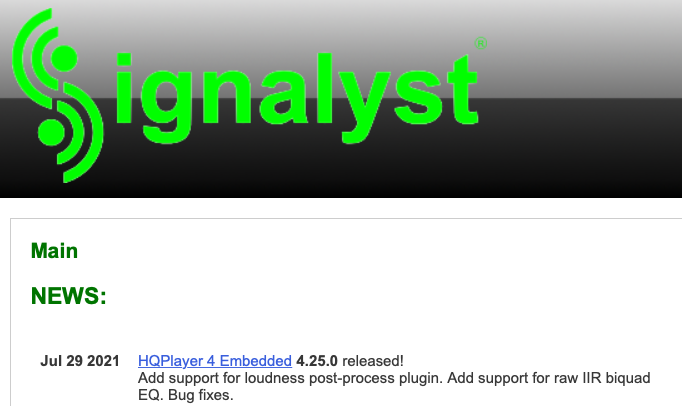
- JRIVER SETTINGS VS HQPLAYER WINDOWS 10
- JRIVER SETTINGS VS HQPLAYER PRO
- JRIVER SETTINGS VS HQPLAYER FREE
- JRIVER SETTINGS VS HQPLAYER WINDOWS
In HQPlayer one has the choice of using either 44.1 or 48kHz "base" and the usual multiples like 64/128/256/512/1024 and a few other atypical choices (like 32kHz base frequency). Of course, you can then specify the "Bit rate" which in this example is "44.1k x512" - also known as DSD512 or 1-bit 22.6MHz. In the lower left are the PCM settings including type of dithering.Īnd for DSD realtime playback, the key parameters are on the right lower part under "SDM Defaults" to select which "Oversampling" algorithm you want to use and below that the "Modulator" used to convert PCM to DSD/SDM. Notice the "Vol Max" has been reduced to -3.0dB which I've read is recommended to prevent overloading although I didn't notice any problems even at 0dB when sending bit perfect through ASIO. I've also activated "Multicore DSP" which is a necessity when offloading to the GPU (you can leave it as a grayed out "Auto" setting). "CUDA offloading" is active for the nVidia GPU.

JRIVER SETTINGS VS HQPLAYER WINDOWS
Doesn't look very nice with Windows scaling but text made easier to read. This is rather in contrast to the much less processor-hungry JRiver 24 which only used 15-25% of the CPU without GPU assistance!īecause HQPlayer has so many different settings, it makes it difficult and time-consuming to check out all the combinations possible (but I'll try to get a good taste of what it does nonetheless). As you can see, about 32% of the CPU and 25% of the GPU were utilized.
JRIVER SETTINGS VS HQPLAYER WINDOWS 10
This is the "Performance" tab in Windows 10 Task Manager when playing back 24/96 PCM as DSD512 using "poly-sinc" oversampling and the "AMSDM7 512" modulator. To give you an idea of processing demands, when doing realtime PCM-to-DSD conversion, this is what the CPU/GPU utilization looks like:

Remember, as discussed, there's no need to worry about "noise" with GPU and CPU's many feet away from my DAC. HQPlayer is processing-hungry and I included the nVidia GTX 1080 GPU above since this is significant as HQPlayer allows one to offload much of the DSD conversion to the GPU which I activated for these tests.
JRIVER SETTINGS VS HQPLAYER FREE
Remember I used various off-line PCM-to-DSD conversion tools and realtime JRiver 24 in that previous post, so feel free to compare. Notice the setup is the same as the recent Oppo UDP-205 DSD playback post - using my Intel i7-3770K computer at stock 3.5GHz base speed up to 3.9GHz Turbo, 16GB DDR3 RAM Windows 10 PC.
JRIVER SETTINGS VS HQPLAYER PRO
Intel i7-3770K CPU + nVidia GTX 1080 GPU Windows 10 computer -> 16' generic USB -> Oppo UDP-205 as DAC -> generic 6' XLR -> RME ADI-2 Pro FS ADC -> generic USB -> Win 10 i5 measurement laptop For the tests today here is the general hardware set-up: The demo will run for 30 days, but 30 minutes at a time - enough time to try out, listen and run samples through the audio analyzer to get an idea of what it's doing. The tests today are done with a recent version of HQPlayer - 3.25.2 available as a demo (I see that there is now a 3.25.3 build available at the time of publication). Well, after all these years, and now with the requisite pieces of hardware at my disposal for a more thorough evaluation (reasonably fast CPU/GPU system, ADC capable of >192kHz, DAC capable of DSD512), it's time to have a peek "under the hood" at what it does. In fact, back in early 2017 when I wrote about Roon 1.2, I mentioned installing HQPlayer but never got around to actually writing about it. It has certainly been on my list of items to look into. In this way, HQPlayer has been a bit of a mystery and I know some folks have had difficulty getting it running over the years. While admittedly I don't follow HQPlayer chatter closely, I don't recall reading about specific settings and what they do other than opinions about the sound quality.

There has been a good amount of talk about the sound quality of the upsampling algorithms and some swear by the sonic differences the program makes. While there is a GUI for playback as well as a sophisticated network transport architecture, it's the upsampling and PCM-to-DSD features that are the program's claim to fame. Over the years, no doubt many computer audio users have heard or perhaps tried using HQPlayer Desktop from Signalyst for music playback.


 0 kommentar(er)
0 kommentar(er)
